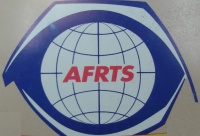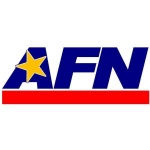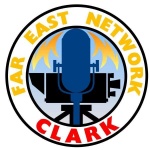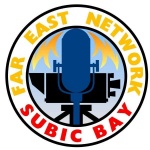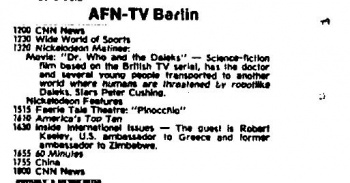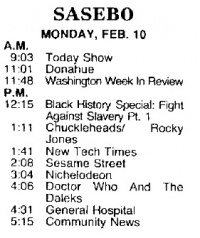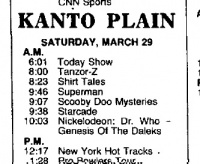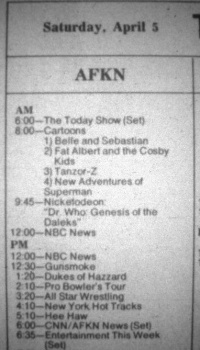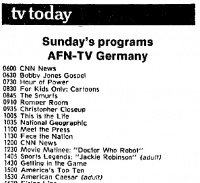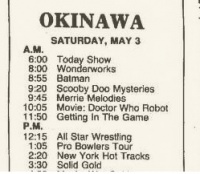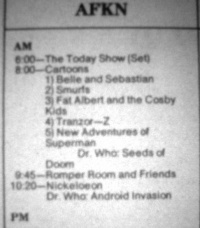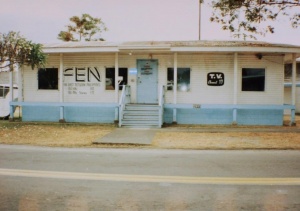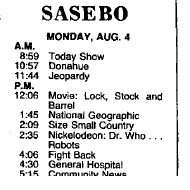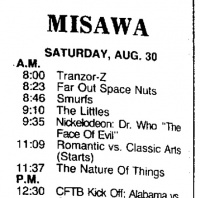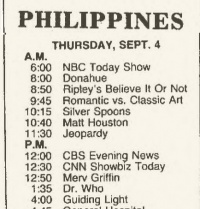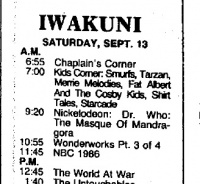Armed Forces Network
The Armed Forces Radio Service (AFRS) was established in May 1942, primarily to provide radio broadcasts to American servicemen abroad. A very basic television service began broadcasting locally from the Limestone Air Force base in Maine from 25 December 1953.
The AFRS was renamed the American Forces Radio and Television Services (AFRTS) in April 1954. This was also known as the Armed Forces Network (AFN).
By early 1955, television stations began operating from US Air Force bases overseas, such as those in Libya (the Wheelus Base in Tripoli), Iceland, Germany, Bermuda, Saudi Arabia (the Dhahran base), and Iran (in Tehran).
In 1966, as the network expanded, the AFRTS Broadcast Center was established in Los Angeles; the centre was responsible for selecting and distributing all programming to the stations. By the 1980s, advancements in satellite technology meant syndication packages of the same programming could be delivered via the SATNET network to all bases at the same time.
FAR EAST NETWORK (FEN)
The stations that served Japan and the Philippines and on islands in the Pacific Ocean were part of the Far East Network (FEN).
Although FEN operated as a network, there were often regional differences and some programmes that aired in Japan did not air in the Philippines and vice versa. For instance, if a national Japanese television station was airing a series that FEN also had the rights to, FEN could not screen it, and so alternative programing was provided by AFRTS. (The FEN was disestablished in 1997 after 54 years of service and is now known as AFN-Japan.)
AFKN KOREA
Although it was also in the Far East, the Air Force Korea Network (AFKN) in South Korea operated separate from the FEN, and as such had a much bigger budget from the AFRTS. AFKN had more alternative programming because of strong competition from local South Korean TV stations which also sought to broadcast popular US shows. By the mid-1960s, microwave and repeater transmitters enabled broadcasts by the AFKN to reach other parts of the country. (AFKN is now known as AFN-Korea.)
By the middle of 1985, with 88 radio stations and 35 land-based television outlets, plus over 1,000 broadcast facilities on American naval vessels, the AFRTS was the largest radio and television network in the world.
Doctor Who on the Armed Forces Network
Although the majority of programming on AFN was American - sourced from the major commercial networks, such as ABC, CBS, FOX and NBC, as well as from PBS, CNN and other cable stations – Tom Baker episodes of Doctor Who formed part of one syndication package that was broadcast by various Armed Forces Network stations in 1986.
One of the reasons why Doctor Who was dropped by AFKN and FEN after only one year may have been due to a self-imposed prohibition on non-US programming. The AFN provided programmes for American military personnel, and as such British programmes like Doctor Who may have been perceived as unpopular (as was reported in a contemporary edition of Stars and Stripes which mentioned there had been complaints about non-US programming).
- NOTE: So far we have identified broadcasts of Doctor Who on the AFN station in Germany, and FEN stations in Japan and the Philippines and AFKN in South Korea only. It is highly probable that other AFN stations in other regions of the world also aired the same run of episodes around the same time, but we have yet to locate listings for these.
Stories bought and broadcast
TOM BAKER
22 stories, equivalent of 94 episodes in omnibus "movie" format:
| 4A | Robot | 4 |
| 4B | The Sontaran Experiment | 2 |
| 4E | Genesis of the Daleks | 6 |
| 4D | Revenge of the Cybermen | 4 |
| 4F | Terror of the Zygons | 4 |
| 4H | Planet of Evil | 4 |
| 4G | Pyramids of Mars | 4 |
| 4J | The Android Invasion | 4 |
| 4K | The Brain of Morbius | 4 |
| 4L | The Seeds of Doom | 6 |
| 4M | The Masque of Mandragora | 4 |
| 4N | The Hand of Fear | 4 |
| 4P | The Deadly Assassin | 4 |
| 4Q | The Face of Evil | 4 |
| 4R | The Robots of Death | 4 |
| 4S | The Talons of Weng-Chiang | 6 |
| 4V | Horror of Fang Rock | 4 |
| 4T | The Invisible Enemy | 4 |
| 4X | Image of the Fendahl | 4 |
| 4W | The Sun Makers | 4 |
| 4Y | Underworld | 4 |
| 4Z | The Invasion of Time | 6 |
For reasons that are not clear, The Ark in Space was not part of this package of episodes. Unlike many other broadcasters, the stories were aired in the correct story order.
Transmission
JAPAN
The AFN stations in US military bases in Japan were part of the Far East Network (FEN).
Doctor Who was available on (at least) these five channels:
1) Kanto Plain (Channel 4)
In terms of the screenings covered by this profile, Kanto Plain was the first of the eight regions to air the series.
Starting from Saturday, 15 March 1986 usually around 10.00am, the 22-week run ended on 9 August 1986.
Although the 19 July episode was billed as being The Invisible Enemy, it was probably Image of the Fendahl, which would have been the next story to air in sequence.
2) Okinawa
In terms of the screenings covered by this profile, Okinawa was the fifth of the eight regions to air the series. (Okinawa was the site of the Kadena Airforce Base and a US Marine Corps facility.)
The programme ran from Saturday, 3 May 1986 until 27 September 1986, at various times prior to noon. One episode aired on Thursday - on 19 June. After that, the Saturday timeslot remained constant, usually around 12.20pm.
3) Misawa (Channel 25)
In terms of the screenings covered by this profile, Misawa was the sixth of the eight regions to air the series. (Misawa was an Airforce base.)
The series aired from Saturday, 31 May 1986 until 25 October 1986, usually at 9.35am.
4) Iwakuni (Channel 22)
In terms of the screenings covered by this profile, Iwakuni was the seventh of the eight regions to air the series. (A Marine Corps Air Service Station was based in Iwakuni.)
The run of episodes played from Saturday, 5 July 1986 until 29 November 1986, usually starting at 9.20am.
5) Sasebo (Channel 23)
In terms of the screenings covered by this profile, Sasebo was the last of the eight regions to air the series. (Sasebo was the location of a US Naval Station.)
The first Peter Cushing Dalek movie, "Dr Who and the Daleks" aired on Monday, 10 February 1986 from 3.04 to 4.31pm. It's highly likely the film also aired on the other stations in Japan (it aired on AFN-TV in Germany in 1985 – see below) but we did not locate those billings.
The regular series commenced from Monday, 4 August 1986, screening usually around 2.00pm. The series then shifted to Saturdays, from 27 September until the final episode on 27 December 1986, usually playing at 10.25am.
- NOTE: The series may have been available on stations operating out of other military bases in Japan, but we have not identified any listings for those.
SOUTH KOREA
The AFKN in South Korea was established in 1957. It operated separate from and was not part of the Far East Network (FEN).
The AFKN broadcast out of Seoul on cable channel 2; Pusan (ch 2); Taegu (ch 12); Taejon (ch 12); Kwangju (ch 13) and Wonju (ch 2).
In terms of the screenings covered by this profile, Korea was the second of the eight regions to air the series.
Doctor Who commenced on Saturday, 22 March 1986, and ended on 16 August 1986, at a timeslot of usually around 10.20am. Although the listing for Genesis of the Daleks is from 9.45am to 12.00, all subsequent 6-parters are billed for the shorter time of 10.20am to 12.00.
PHILIPPINES
The AFN stations in the Philippines were part of the Far East Network (FEN). There were a number of stations in operation, serving different parts of the country, such as:
- Channel 17, a UHF channel that served the US Naval Station Subic Bay and the US Naval Air Station Cubi Point in Subic, Zambalas and Bataan Province. The area was ringed by mountains so the signal did not go very far. (As with many of the FEN channels, the "station" was often little more than a small hut – as this photo of the Channel 17 repeater station in Subic illustrates). The signal was also available to Barrio Barreto and Olongapo City, which also received transmissions by way of cable feed.
- Channel 14, served Clark Air Force base (see logo at top of the page), Wallace Air Station, and Camp O'Donnell in the Angeles City area.
- Channel 34, which served the Naval Communication Station San Miguel, the Naval Link Station Santa Rita.
- Channel 50, operated from Manila, and mainly served Administrative US Military and US Embassy staff working in the capital.
- An additional transmitter high up in the mountains reached Baguio City, and serviced the USAF base at Camp John Hay, while a fourth transmitter was in the capital, Manila, but that had been shut down in 1986 due to complaints from local TV stations over conflicting programme content. It went back on the air with a scrambled signal in 1989.
In terms of the screenings covered by this profile, the Philippines was the third of the eight regions to air the series.
Doctor Who was aired by the FEN Philippines channels, commencing on Thursday, 10 April 1986, and concluded on 4 September 1986, at various timeslots, but usually starting around 1.40pm or 2.30pm.
In June 1991 a number of FEN Philippines stations were forcibly shut down permanently due to the volcanic eruption of Mount Pinatubo.
GERMANY
AFN-TV Berlin and AFN-TV Germany were two of the American Forces Network – Europe stations.
In terms of the screenings covered by this profile, Germany was the fourth of the eight regions to air the series.
The first Peter Cushing Dalek movie, "Dr Who and the Daleks" aired as the AFN-TV Berlin "Nickelodeon Matinee" on Saturday, 9 November 1985 at 1.20pm. (The film aired on other AFN stations – such as on Sasebo, see above.)
The regular series commenced on Sunday, 13 April 1986, and concluded on 7 September 1986. All episodes aired from 12.30pm until 2pm, or by 3.00pm for the 6-parters.
Listings for AFN-TV Germany place the episodes under the banner of the "Movie Matinee" rather than "Nickelodeon" as was used by the other stations.
Pertwee Stories?
BBC sales paperwork also records a sale to "West German Basic Cable" of the Jon Pertwee story The Mutants by April 1991.
The sale of that story – and presumably a package of other Pertwee episodes – may have been to this European AFN station, however we could not find any listings for Doctor Who in the early 1990s other than for those episodes screened by RTL, as is covered on the profile page for Germany.
TV listings
| ← AIRDATES ...... (CLICK ICON TO GO TO TABLE SHOWING EPISODE BREAKDOWN AND AIRDATES - N/S = story title is Not Stated) |
NOTE: The TV listings always give the billings for the series as "Nickelodeon: Dr Who" or sometimes just "Nickelodeon". We think use of that name is merely a generic Movie for Children descriptor rather than an indication that the programme is from the much later-established Nickelodeon franchise of international channels, such as Nickelodeon (Japan) and Nickelodeon (Korea).
All listings have come from the European or Japanese editions of the US Military newspaper Stars and Stripes. Story titles were given in most cases, although from September, just "Nickelodeon" was used for the Japan listings.
For the screenings in Korea, listings were also sourced and verified from the Korea Times.
On 24 May and 31 May 1986, a printing error in the Korean Times places both The Android Invasion and The Seeds of Doom in the same listing.
For some regions, for The Invasion of Time, the listing simply said "(End)".
